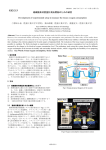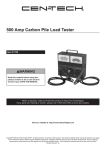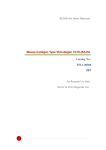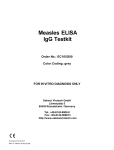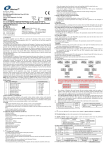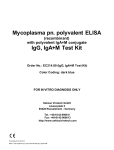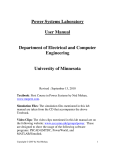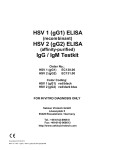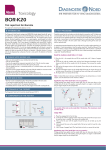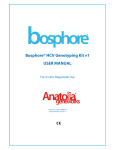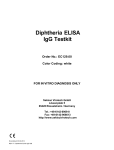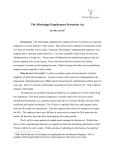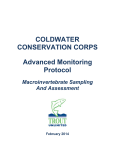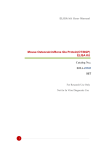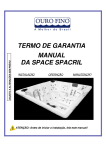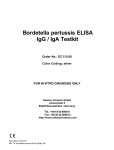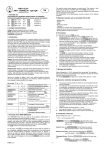Download Package Insert
Transcript
Instructions for Use Borrelia burgdorferi Veterinary ELISA Species B. burgdorferi sensu stricto to determine IgG antibodies to Borrelia burgdorferi in dog or horse serum Order No.: DC122.00 Color code: gold The German Instructions for Use have been a pproved in accordance with §17c TierSG under the Registration Number FLI-B 397. FOR IN VITRO DIAGNOSIS ONLY Sekisui Virotech GmbH Löwenplatz 5 65428 Rüsselsheim - Germany Tel.: +49-6142-6909-0 Fax: +49-6142-966613 http://www.sekisuivirotech.com Druckdatum 03.02.2014 REV 2 / Borrelia burgdorf eri Veterinär ELISA IgG GB Content 1. Intended Use ......................................................................................................................... 3 2. Diagnostic Relevance ............................................................................................................ 3 3. Test Principle......................................................................................................................... 3 4. Package Contents ................................................................................................................. 3 5. Storage and Shelflife of the testkit and the ready to use reagents ........................................ 4 6. Precautions and Warnings .................................................................................................... 4 7. Material required but not supplied......................................................................................... 4 8. Test Procedure ...................................................................................................................... 5 8.1 8.2 8.3 8.4 9. Examination Material....................................................................................................................................................... 5 Preparation of Reagents ................................................................................................................................................. 5 Virotech ELISA Test Procedure....................................................................................................................................... 5 Usage of ELISA processors ............................................................................................................................................ 5 Test Evaluation ...................................................................................................................... 6 9.1 9.2 9.3 9.4 Test function control........................................................................................................................................................ 6 Calculation of the Vir otech Units (VE) ............................................................................................................................. 6 Interpretation Scheme IgG .............................................................................................................................................. 6 Limits of the Test............................................................................................................................................................. 7 10. Performance Data .................................................................................................................. 7 10.1 Sensitivity and Specif icity ................................................................................................................................................ 7 10.2 Cross-Reactivity .............................................................................................................................................................. 7 11. Literature ............................................................................................................................... 7 12. Test Procedure Scheme ........................................................................................................ 9 Seite 2 v on 9 Borrelia burg dorf eri Veterinär ELISA IgG GB REV 2 Druckdatum 03.02.2014 1. Intended Use The Virotech Borrelia burgdorferi (Species B. burgdorferi sensu stricto) Veterinary ELISA is an indirect ELISA for the semiquantitative and qualitative detection of specific IgG antibodies in dog or horse serum. 2. Diagnostic Relevance General The pathogen for borreliosis, the spirochaete Borrelia burgdorferi, w as discovered in 1981 by Burgdorfer and Barbour and classified as a species of the genus Borrelia (1). 3 species of Borrelia burgdorferi sensu lato have now been identified: Borrelia burgdorferi sensu stricto, Borrelia garinii and Borrelia afzelii (2). Epidemiology: Borreliosis occurs endemically in all temperate zones (3). There are how ever differences in the relative frequency of the 3 pathogens in different regions. Thus, only B. burgdorferi sensu stricto has been observed in North America, but all three species have been found in Europe (2). Transmission: B. burgdorferi is predominantly transmitted by hard ticks of the genus Ixodes w hen they bite or suck blood. Ixodes scapularis is the vector know n in the USA; Ixodes ricinus is the main vector in Europe 4). Clinical picture in the dog: It is generally accepted that the most characteristic symptoms of Lyme borreliosis in the dog are impaired w ell-being, w ith anorexia and fever, with fluctuating lameness and arthritis. Lameness and arthritis are really pathognomic symptoms. Aside from these symptoms, lymphadenopathies are observed in about 5% of cases and impairment of renal function in about 2% of cases. The latter may be severe (5). Clinical picture in the horse: Horses are often bitten by ticks w hen they are grazing on the meadow . In w estern and central Europe, these are almost alw ays of the species Ixodes ricinus, w hich sucks the bloody of horses in all three stages – the adult, the nymph and the larva (5). In a German study (Hannover), the symptoms of the disease w ere determined in 50 horses. The high pr oportion of eye diseases - conjunctivitis, keratoconjunctivitis, retinitis – w as striking; this is consistent w ith observations in the USA. On the other hand, the horses w ere most often taken to the vet because of general and less specific symptoms – such as loss of w eight and energy (24%), inflamed joints (12%) and lameness (10%). Polyarthritis w as often found and this can occur in almost any joint in the extremities (6). 3. Test Principle The test antibodies in the animal serum form an immune complex w ith the antigen fixed on the microtitre plate. The antibody searched for in the human serum forms an immune complex w ith the antigen coated on the microtitre -plate. Unbound immunoglobulins are removed by w ashing processes. The enzyme conjugate attaches to this c omplex. Unbound conjugate is again removed by w ashing processes. After adding the substrate solution (TMB), a blue dye is produced by the bound enzyme (peroxidase). The color changes to yellow w hen the stopping solution is added. 4. Package Contents 1. 2. 3. 4. 5. 6. 7. 8. 1 Microtitre-Plate [MTP] consisting of 96 w ith antigen coated, breakable single w ells, lyophilised PBS-Dilution Buffer, (blue, ready to use), 2x50m l, pH 7,2, w ith preservative and Tw een 20 PBS-Washing Solution, 50ml, (20x concentrated), pH 7,2, w ith preservative and Tw een 20 IgG negative control dog [NEG IgG Dog], 1300µl, dog serum w ith protein stabilizers and preservative, ready-to-use IgG cut-off control dog [CO IgG Dog], 1300µl, dog serum w ith protein stabilizers and preservative, ready -to-use IgG positive control dog [POS IgG Dog], 1300µl, dog serum w ith protein stabilizers and preservative, ready-to-use Anti-Dog-IgG conjugate, 11ml, rabbit horseradish peroxidase conjugate, contains preservative, ready-to-use IgG negative control horse [NEG IgG Horse], 1300µl, horse serum w ith protein stabilizers and preservative, ready -touse Seite 3 v on 9 Borrelia burg dorf eri Veterinär ELISA IgG GB REV 2 Druckdatum 03.02.2014 9. 10. IgG cut-off control horse [CO IgG Horse], 1300µl, horse serum w ith protein stabilizers and preservative, ready -to-use IgG positive control horse [POS IgG Horse], 1300µl, horse serum w ith protein stabilizers and preservative, ready-touse Anti-Horse-IgG conjugat,e 11m l, goat horseradish peroxidase conjugate, contains preservative, ready-to-use Tetramethylbenzidine substrate solution (3,3’,5,5’-TMB), 11m l, ready to use Citrate-Stopping Solution, 6m l, contains an acid mixture 11. 12. 13. 5. Storage and Shelflife of the testkit and the ready to use reagents Store the testkit at 2-8°C. The shelf life of all compoments is show n on each respective label; for the kit shelf life please see Quality Control Certificate. 1. 2. 3. Microtiter strips/single w ells are to be resealed in package after taking out single w ells and stored w ith desiccant at 2-8°C. Reagents should immediately be returned to storage at 2-8°C after usage. The ready to use conjugate and the TMB-substrate solution are sensitive to light and have to be stored in dark. Should there be a color reaction of the substrate dilution due to incidence of light, it is not useable anymore. Take out only the amount of ready to use conjugate or TMB needed for the test insertion. Additional conjugate or TMB taken out may not be returned but must be dismissed. Material Controls Status Diluted Undiluted After Opening Microtitreplate After Opening Rheumatoid factor Absorbent Conjugate Tetramethylbenzidine Stop Solution Undiluted, After Opening Diluted After Opening After Opening After Opening After Opening Final Dilution (ready-to-use) Test Samples Washing Solution 6. Storage +2 to +8°C +2 to +8°C +2 to +8°C +2 to +8° (storage in the provided bag w ith desiccant bag) +2 to +8°C +2 to +8°C +2 to +8°C (protect from light) +2 to +8°C (protect from light) +2 to +8°C +2 to +8°C +2 to +25°C Shelflife max. 6h 1 w eek 3 months 3 months 3 months 1 w eek 3 months 3 months 3 months 3 months 4 w eeks Precautions and Warnings 1. 2. 3. 7. Only sera w hich have been tested and found to be negative for HIV -1 antibodies, HIV-2 antibodies, HCV antibodies and Hepatitis-B surface-antigen are used as control sera. Nevertheless, samples, diluted samples controls, conjugate and microtiter strips should be treated as potentially infectious material. Please handle products in accordance with laboratory directions. Those components that contain preservatives, the Citrate Stopping Solution and the TMB have an irritating effect to skin, eyes and mucous. If involved body parts are contacted, immediately w ash under flowing water and possibly look up a doctor. The disposal of the used materials is effected referring to the country -specific guidelines. Material required but not supplied 1. 2. 3. 4. 5. 6. 7. 8. 9. Aqua dest./demin. Eight-channel pipette 50µl, 100µl Micropipettes: 10µl, 100µl, 1000µl Test tubes Paper tow els or absorbent paper Cover for ELISA-plates Disposal box for infectious material ELISA handw asher or automated EIA plate w ashing device ELISA plate spectrophotometer, w avelength = 450nm, reference length = 620nm (Reference Wavelength 620-690nm) Seite 4 v on 9 Borrelia burg dorf eri Veterinär ELISA IgG GB REV 2 Druckdatum 03.02.2014 10. 8. Incubator Test Procedure Working exactly referring to the Sekisui Virotech user manual is the prerequisite for obtaining correct results. 8.1 Examination Material Sera are used as examination material. Alw ays prepare samples-dilution freshly. For a longer storage the sera must be frozen. Repeated defrosting shall be avoided. 1. 2. 8.2 Only fresh non-inactivated sera should be used. Hyperlipaemic, haemolytic, microbially contaminated and turbid sera should not to be used (false positive/negative results). Preparation of Reagents The ready-to-use controls (positive control, cut-off control, negative control) are parameter- and species-specific and are to be used exclusively w ith the plate batch in the kit. The ready-to-use conjugates are also parameter- and species-specific, but may be used for different plate batches. 1. 2. 3. 4. Set incubator to 37°C and check proper temperature setting before start of incubation. Bring all reagents to room temperature before opening package of microtiter strips. Shake all liquid components w ell before use. Make up the w ashing solution concentrate to 1 L w ith distilled or demineralised w ater. If crystals have formed in the concentrate, please bring the concentrate to room temperature before use and shake w ell before use. 1. For each test batch, pipette 100µl each of the ready-to-use dilution buffer (blank), the negative, positive and cut-off IgG controls, together w ith the diluted animal sera. We recommend that adjacent duplicates should be performed for the blank, controls and sera samples; it is absolutely essential that the cut-off control should be performed in duplicate. Working dilution of the animal sera: 1:400; e.g. predilution: Mix 10µl serum + 90µl dilution buffer (1:10); Second dilution: Take 10µl of this mixture and pipette 390µl dilution buffer into it (1:40). This corresponds to a dilution of 1:400. After pipetting start incubation for 30 min. at 37°C (w ith cover). End incubation period by w ashing microtiter strips 4 times w ith 350 µl w ashing solution per w ell. Do not leave any w ashing solution in the w ells. Remove residues on a cellulose pad. Pipette 100µl of the ready-to-use animal-specific conjugate into all w ells. Incubation of the conjugate: 30 min. at 37°C (w ith cover) Stop conjugate incubation by w ashing 4 times (pls. refer to point 3 above). Pipette 100µl of ready to use TMB into each w ell. Incubation of substrate solution: 30 min. at 37°C (w ith cover, keep in dark). Stopping the substrate reaction: Pipette 50µl citrate stop solution into each cavity. Carefully and thoroughly shake the plate until the fluids are w ell mixed and the colour in each w ell is homogenous. Measure extinction (OD) at 450/620nm (Reference Wavelength 620-690nm). Set your photometer in such a w ay that the blank value is deducted from all other extinctions. Extinctions should be measured w ithin 1 hour after adding the stopping solution! 8.3 Virotech ELISA Test Procedure 2. 3. 4. 5. 6. 7. 8. 9. 10. Pls. refer to last page for Test Procedure Schemata 8.4 Usage of ELISA processors All Sekisui Virotech ELISAs can be used on ELISA processors. The user is bound to proceed a validation of the devices (processors) on a regular basis. Seite 5 v on 9 Borrelia burg dorf eri Veterinär ELISA IgG GB REV 2 Druckdatum 03.02.2014 Sekisui Virotech recommends the follow ing procedure: 1. Sekisui Virotech recommends to proceed the validation of device referring to the instructions of the device manufacturer during the implementation of the ELISA processor respectively after bigger reparations. 2. It is recommended to check the ELISA-processor w ith the Validationkit (EC250.00) afterw ards. A regular check using the Validationkit shall be proceeded minimum once a quarter to test the accuracy of the processor. 3. The release criteria of the Quality Control Certificate of the product must be fulfilled for each testrun. This procedure ensures the accuracy of your ELISA processor and serves additionally for the Quality Assurance of your laboratory. 9. Test Evaluation The ready-to-use controls serve as quantification controls for the semiquantitative determination of specific igG antibodies; the concentration can be given in Virotech Units = VE. The method can correct for fluctuations in the test procedure, leading to high reproducibility. The mean OD value is used to calculate the VE. 9.1 Test function control a) OD-values The OD of the blank should be < 0.15. The OD-values of the negative controls should be low er than the OD-values mentioned in the Quality Control Certificate. The OD-values of the positive controls as w ell as of the cut-off controls should be above the OD-values mentioned in the Quality Control Certificate. b) Virotech Units (VE) The Virotech Units (VE) of the cut-off controls are defined as 10. The calculated VE of the positive controls should be w ithin the ranges mentioned in the Quality Control Certificate. If those requirements (OD-values, VE) are not fulfilled, the test has to be repeated. 9.2 Calculation of the Virotech Units (VE) The mean is calculated from the duplicate OD values. The extinction of the blank value (450/620nm) has to be subtracted from all other extinctions. OD (positivecontrol) x 10 OD (cut - off control) OD (animal serum) x 10 OD (cut - off control) VE (positivecontrol) VE (animal serum) 9.3 Interpretation Scheme IgG Result (VE) < 8,0 8,0 - 12,0 > 12,0 1. 2. Evaluation negative grey area positive If the VE value measured for the sample is greater than 12 VE, the sample is considered to be positive. If the VE value measured lies w ithin the grey area, there is no significant increase in antibody concentration and the samples are regarded as threshold. If an infection is to be reliably detected, the antibody concentration must be determined in tw o serum samples: a serum sample directly after the start of the infection and a second sample tw o weeks later. The antibody concentrations in the tw o samples must be measured in parallel, in a single test batch. A correct diagnosis cannot be made on the basis of a single serum sample. Seite 6 v on 9 Borrelia burg dorf eri Veterinär ELISA IgG GB REV 2 Druckdatum 03.02.2014 3. If the measured values are under the defined grey area, there are no measurable antigen-specific IgG antibodies in the sample. The sample is classified as negative. 1. The interpretation of serological results shall alw ays include the clinical picture, epidemiological data and all further available laboratory results. 9.4 Limits of the Test 10. Performance Data 10.1 Sensitivity and Specificity IgG Detection in the Dog In order to determine the performance of the Borrelia burgdorferi Veterinary ELISA, 351 sera w ere tested in the Sekisui Virotech ELISA and in the reference tests (ELISA and Western blot). The tests w ere performed in the laboratories of Sekisui Virotech GmbH, Rüsselsheim, and of Maastricht University. 35 sera w ere positive in both tests and 278 sera negative in both tests. For 6 sera, the results of the tw o tests did not agree. Threshold results (32) w ere excluded from the calculation. The result is show n in the follow ing table. Reference Test + Virotech - + 35 6 - 0 278 Specific ity = 98% Sensitivity = 100% IgG Detection in the Horse In order to determine the performance of the Borrelia burgdorferi Veterinary ELISAs, 119 sera w ere tested in the Sekisui Virotech ELISA and in the reference test (Western Blot). The tests w ere performed in the laboratories of Sekisui Virotech GmbH, Rüsselsheim. 3 sera w ere positive in both tests, 69 sera negative in both tests and 13 sera gave threshold values in both tests. For 3 sera, the results of the tw o tests did not agree. Threshold results (34) w ere excluded from the calculation. The result is show n in the follow ing table. Reference Test Virotech + + 3 3 - 0 69 Specificity = 96% Sensitivity* = 100% *This is calculated as 100% sensitivity, How ever, this value is statistically unreliable, as only 3 positive Borrelia IgG sera w ere available for testing. 10.2 Cross-Reactivity There has been much discussion about cross -reactions betw een B. burgdorferi and other spirochaetes, particularly Leptospira (5). In a study of Leptospira-positive dog and horse sera, no cross-reactivity w as found in the Borrelia burgdorferi Veterinary ELISA. 11. Literature 1. Burgdorfer, W., Barbour, A.G., Hayes S.F. et al. (1982); Lyme disease – a tick-borne spirochetosis?; Science 216:131719. Seite 7 v on 9 Borrelia burg dorf eri Veterinär ELISA IgG GB REV 2 Druckdatum 03.02.2014 2. 3. 4. 5. 6. Dressler, F., Ackermann, R. and Steere, A .C. (1994); Antibody responses to the three genomic groups of Borrelia burgdorferi in European Lyme Borreliosis; J. Infect. Dis. 169:313-318. Sigal, L.H. and Curran, A.S.; Lyme disease: a multifocal w orldwide epidemic; Annu. Rev. Publ. Health (1991); 12:85-109. Barbour, A.G. and Hayes, S.F. (1986); Biology of Borrelia species; Microbiol. Rev. 50(4):381-400. Horst, H.; Einheimische Zeckenborreliose (Lyme-Krankheit) bei Mensch und Tier; 3. überarbeitete Auflage; DemeterVerlag im Spitta Verlag; 1997: 173-174, 176-178. Liebisch, G.; Der Nachw eis von Borrelien bei Haus und Wildtieren: Patienten oder Reservoir der Lyme-Borreliose?; 22. Kongress der Deutschen Veterinärmedizinischen Gesellschaft; 8.-11. April 1997; Bad Nauheim. Seite 8 v on 9 Borrelia burg dorf eri Veterinär ELISA IgG GB REV 2 Druckdatum 03.02.2014 12. Test Procedure Scheme Preparation of Dog- /Horse Serum and Washing Solution ▼ Washing Solution: Fill up concentrate ▼ to 1 liter with aqua dest./demin. Samples Dilution 1:400 z.B.: Mix 10 µl serum + 90µl dilution buffer (serum dilution buffer is ready-to-use) Mix 10µl of this mixture w ith 390µl dilution buffer. Testprocedure Samples Incubation 30 minutes at 37°C 100 µl Dog- /Horse Serum blank value (Dilution Buffer) and controls 350 µl Washing Solution Wash 4times Remove Residues on a Cellulose Pad Conjugate Incubation 30 minutes at 37°C 100 µl Conjugate IgG 350 µl Washing Solution Wash 4times Remove Residues on a Cellulose Pad Substrate Incubation Stopping 30 minutes at 37°C 100 µl Substrate 50 µl Stopping Solution shake carefully Measure Extinctions Seite 9 v on 9 Borrelia burg dorf eri Veterinär ELISA IgG GB Photometer at 450/620nm (Reference Wavelength 620690nm) REV 2 Druckdatum 03.02.2014









